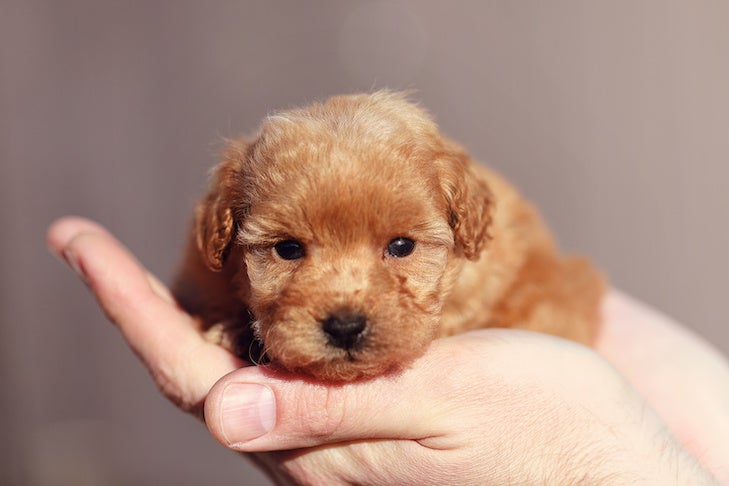What tugs at our hearts more than an adorable Chihuahua peeking out of Reese Witherspoon’s purse in the movie Legally Blonde? Perhaps it is the sight of puppies glee fully romping through scenes in 101 Dalmatians, or the exploits of Otis, the endearing Pug, in The Adventures of Milo and Otis. Dogs occupy a treasured place in our hearts. The public loves it when man’s best friend is featured in the media — whether in movies, television shows, or even commercials. But while the general public may be delighted by these appearances, most breeders are not. During the season of Sex and the City when a Cavalier King Charles Spaniel became part of the storyline, breeder Heidi Mohn of Covington Cavaliers was concerned:
“I know the phone will ring off the hook over the next few weeks, and even months. I’m concerned about the impulse buyer who wants a puppy today. If they can’t get one, or are unwilling to pay the price for one from a reputable breeder, they will get one from someone not so reputable. In that case, both the buyer and seller are uneducated and they haven’t taken into account what it means to own a Cavalier.
“Even more concerning is filtering through those that think there is quick money to be made on the hype and want to start breeding Cavaliers. These people have absolutely no understanding of the breed, its history, its health problems, and most importantly, its future.”
Unfortunately, popularity causes problems that can have a detrimental effect on purebred dogs. Breeds thrown into the public spotlight by the media are even more prone to these problems. Television and movies reach a large audience, and the public’s awareness of a particular breed can appear to spring up overnight. When this happens, the demand for breed-specific puppies increases dramatically, fueled by impulse buyers who want to purchase a puppy immediately. These buyers seldom take the time to research a breed or find reputable, ethical breeders. And their demand for puppies creates powerful economic incentives for breeders willing to overproduce poor-quality dogs without regard for health issues or breed standards.

At the heart of the problems caused by breed popularity is uneducated public demand, particularly from impulse buyers. When a breed becomes popular because of exposure in movies or television-such as the Chihuahua featured in Taco Bell commercials—large numbers of impulse buyers start looking for places to buy the breed, and many (if not most) of them fail to take the time to find a reputable breeder. Often, this can be chalked up to ignorance — many impulse buyers simply don’t know the importance of buying from a good breeder. But many others just don’t care where they get the dog they want, as long as they get it as soon as possible. And as long as there is strong demand for a breed, indiscriminate breeders will step in to fill it. This is particularly true if a breed’s popularity rises suddenly, as with Dalmatians. If there’s quick money to be made by selling dogs, irresponsible breeders will be breeding with only one concern: giving an eager public more dogs, with no attention to what’s in the best interests of the breed.
Sadly, there will always be people who look at a breed’s rising popularity as an opportunity to make money. In a relatively short time, such indiscriminate breeders can affect the temperament, soundness, and breed type of many dogs and give a specific breed a bad reputation.
Case in Point
The ups and downs of Dalmatians dramatically illustrate the negative effect that popularity can have on a breed. In 1996, when the live-action movie 101 Dalmatians was released, breeders were flooded with calls from people who wanted puppies. AKC registration numbers for Dalmatians skyrocketed, bringing the breed into the top 10. To stem this tide of popularity, the Dalmatian Club of America (DCA) spread the word that Dalmatians are not right for everyone.
Dr. Charles Garvin, President of the DCA and an AKC judge, points out, “The media likes to exaggerate the negative, and our message went from ‘Dalmatians aren’t for everyone’ to ‘Dalmatians aren’t for anyone.’”
In the midst of this, veterinarians saw a rise in irresponsibly bred Dalmatians with temperament problems, and some advised clients against owning them. Despite the “instant stardom” status the breed achieved due to 101 Dalmatians, they began to fall out of favor in a very short period. Within a couple of years, registration numbers had fallen 97 percent. This had a devastating effect on the breed. Large numbers of young Dalmatians were being turned over to rescue organizations. Responsible breeders had to cut back on their breeding programs. Others left the breed entirely because they did not want to be thought of as being “in it for the money.” “Breeders cut back on their breeding programs so much that today we’re faced with losing certain bloodlines altogether,” notes Joanne Nash of Rambler Dalmatians.

However, when it comes to purebred dogs, all breeds are not equally attractive to this kind of breeder. Each breed has unique characteristics, some of which make it better suited for overproduction. Interviews with breeders from several different breeds, including Pugs, Chihuahuas, Poodles, Cocker Spaniels, Cavalier King Charles Spaniels, Dalmatians, and Labrador Retrievers, reveal many of these characteristics.
Breeds that are generally easy whelpers and have large litters are more likely to spark the interest of breeders who want to maximize profit margins. If a breed has known difficulties whelping litters and routinely needs C-sections, it will quickly fall out of favor with many high-volume breeders. As Garvin points out, “Dalmatians are generally easy whelpers who have an average of seven to eight puppies in a litter.”
This may have contributed to the explosion of Dalmatian puppies that occurred after 101 Dalmatians was released. Size is another factor that seems to affect whether a breed is overproduced. As all dog owners know, dogs take up space. The bigger the dog, the more space you need. So someone might be able to keep eight Chihuahuas in the same space as one Labrador Retriever. Again, some irresponsible breeders find it more profitable to keep large numbers of dogs in whatever space they have available.
Ease of grooming, which is related to coat length, is another issue that may affect the desirability of a breed to unprincipled breeders. AKC judge and Poodle breeder Dr. Jacklyn Hungerland believes that the Poodle’s coat has kept many monetary breeders at bay: “Poodles are not short-coated, and their coats are not easy to take care of.”
Each of these elements may influence the degree to which a breed becomes prey to unscrupulous breeders. Losing a breed’s original look, function, health, or temperament through haphazard breeding is a high price to pay for popularity. This is why ethical breeders do everything within their power to protect their dogs. Although responsible breeders have little control over breed popularity, which can come and go like fashion trends, they can choose how to manage that popularity. Breed clubs in particular play a vital role in protecting a breed and managing the effects of popularity.

Education is Key
“We learned a lot from our experience with 101 Dalmatians, and by the time 102 Dalmatians came out, DCA was much better prepared,” notes Garvin. “We were able to work with Disney to tone down some of their promotions and they agreed to let us hand out DCA- prepared educational brochures at some of the bigger movie premieres. We realized that approaching them as an adversary wasn’t going to help the situation and that compromises would need to be made.”
Overwhelmingly, breed clubs have found that the key to managing popularity is a strong educational program. In the 1940s and ’50s, with three Best in Show wins at Westminster, Cocker Spaniels’ popularity soared. Popularity led to overproduction of poor quality Cockers, and like Dalmatians, the breed got a reputation for having poor temperaments. Since that time, the American Spaniel Club has worked diligently to protect the breed and educate the public.
“As a club, we’ve tried to emphasize the original function and versatility of the breed to the public. We encourage pet owners to compete in hunt tests, plus agility and obedience,” said Dr. Alvin Grossman, president of the American Spaniel Club and AKC judge. “We also rotate our national show between five different zones across the United States and offer an annual flushing spaniel show. This helps us connect with and educate Cocker owners throughout the country. Of course we wish this breed had never been so popular, but we’ve put together a lot of educational programs, including ones for breeders, in order to encourage responsible breeding and ownership. We’ve also produced educational videos for regional clubs in order to encourage further understanding about our breed.”
Since national breed clubs play a fundamental role in protecting a breed, many view careful screening of potential members as an additional step toward controlling a breed’s fate. Hungerland says, “Poodle breeders are a fierce group when it comes to protecting our breed. We have very stringent guidelines for membership to the Poodle Club of America (PCA). Every member of PCA gets a vote, which means that every member can affect changes to the breed standard. This is why we have such rigorous guidelines for membership; we want to protect our standard. But, we have also established a wonderful educational and research foundation for the breed.”

Go Right to the Source
It’s also important to get potential buyers to the right source: ethical, reputable breeders. Carole Jeffrey, education chairman for the Chihuahua Club of America, notes, “We took out an advertisement in a popular pet-dog magazine aimed at people looking for Chihuahua puppies, and our email inquiries increased 31 percent. It’s important to us to get people to good breeders and give them accurate information about the Chihuahua.” Most breed clubs have established an easily accessible breeder referral list that helps people find local breeders who are in good standing with the national club.
AKC judge and Pug breeder Charlotte Patterson adds that once you make contact with people interested in your breed, “It’s important for breeders to be truthful about the positives and negatives of that breed. Responsible breeders need to take the time to talk to people and give them a balanced picture of the breed they’re interested in owning.”
Another way that breed clubs manage popularity is through a strong rescue network. Inevitably, cute puppies bought in haste grow up, and for many different reasons, their owners no longer want them. Breed clubs play a vital role in rehoming dogs turned in to rescue groups and intervening in cases of neglect. Rescue work happens at the local level through regional clubs affiliated with the national club. National breed clubs do everything they can to support these rescue efforts. Garvin says, “The DCA helps out as much as we can with rescue by helping regional clubs under stand how to do rescue, including what works and what doesn’t.”
In the end, the best way to protect a breed from the negative effects of popularity is through vigilant public education. Many breeders cringe and groan when the public “discovers” their breed. They complain bitterly that if it weren’t for publicity, their breed would be safe from shady breeders and irresponsible owners. The truth is that in this day and age, when so many people have access to information through television and the internet, there is no way to control the attention that a breed receives. What can be controlled is how effectively a breed club deals with the resulting popularity and how quickly they recognize the need to do so.
The love affair the public has with dogs will continue for generations to come. Although the use of dogs in television, movies, or print advertising shows no signs of slowing down, there will always be responsible breeders dedicating their lives to protecting the next popular breed.

